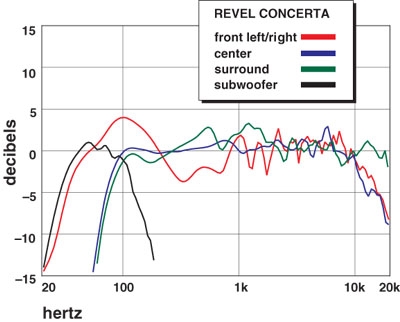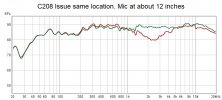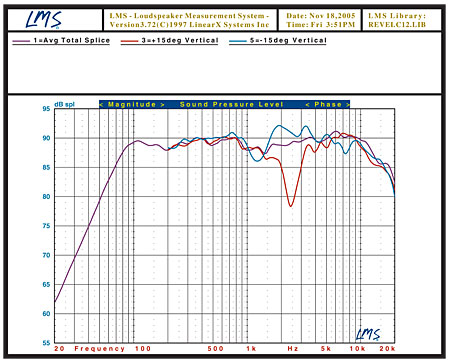Hey there DIY'ers. I recently ordered an old but "new" Revel C12. It's a 3-way center channel from the aughts.

Unfortunately, it was immediately clear something was wrong with the speaker, and later measurements showed a very deep null around 3.5 kHz.
It seemed like an honest mistake and I've resolved it with the seller, but now I'm wondering if I can salvage the speaker.
As some of you may know, I'm very experienced with measuring finished speakers but know little about actually designing speakers. Thought this could be a fun project to learn from.
The only available measurements for the speaker I could find are the following (both separate measurements from Sound and Vision for some reason):

and

My own quasi-anechoic on-axis measurements, unfortunately, showed the following:

The in room response was a bit better, but clearly still broken:

The bass and mid woofers on their own seem totally fine though (nearfield measurements summed and corrected for baffle step), but in nearfield the tweeter seems like it doesn't reach as low as it should:

I did try physically inverting the polarity of the tweeter, but that only helped a little bit on-axis; the in room response was the same.
Harman customer support has yet to respond to me about whether they have any replacement tweeter's in stock.
Any ideas on how I might go about finding a replacement tweeter? Or do you think it's possible the crossover needs fixing too?
I appreciate your help. I'm a newb in this area .
Unfortunately, it was immediately clear something was wrong with the speaker, and later measurements showed a very deep null around 3.5 kHz.
It seemed like an honest mistake and I've resolved it with the seller, but now I'm wondering if I can salvage the speaker.
As some of you may know, I'm very experienced with measuring finished speakers but know little about actually designing speakers. Thought this could be a fun project to learn from.
The only available measurements for the speaker I could find are the following (both separate measurements from Sound and Vision for some reason):

and
My own quasi-anechoic on-axis measurements, unfortunately, showed the following:
The in room response was a bit better, but clearly still broken:
The bass and mid woofers on their own seem totally fine though (nearfield measurements summed and corrected for baffle step), but in nearfield the tweeter seems like it doesn't reach as low as it should:
I did try physically inverting the polarity of the tweeter, but that only helped a little bit on-axis; the in room response was the same.
Harman customer support has yet to respond to me about whether they have any replacement tweeter's in stock.
Any ideas on how I might go about finding a replacement tweeter? Or do you think it's possible the crossover needs fixing too?
I appreciate your help. I'm a newb in this area .


